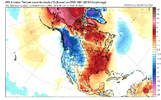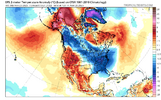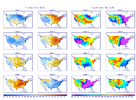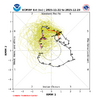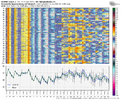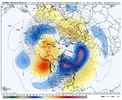lexxnchloe
Member
LC says Deal With It
So you were waiting for that big Arctic outbreak to sweep across your hometown? Keep waiting.
There will be a transient cold intrusion that moves from the Great Plains through the Eastern Seaboard during the Thanksgiving holiday weekend, That could send you chills for two or three days and maybe bring some snow to the Great Lakes and interior Northeast. But with no strong, holding blocking in the high latitudes, any hope of seeing a long-lasting cAk air mass can be rated as "slim" and "none". I am hearing all kinds of talk about a stratospheric warming/splitting event, and while that is a possibility the surface reflection on cold dispersal in the lower atmosphere must wait two to four weeks before being felt at the surface, and then only to the downstream in the south and east sectors of the greatest thermal disruption at 10MB. I suspect that there could be notable temperature drops in later December in association with the upper warmth, but the cold readings might only be transient.
You can blame the Southeast ridge, which in a moderate La Nina happens often. And this is a full-tilt, Pacific Basin wide episode, even though all of the numerical models show a transition to an ENSO neutral/positive or even a weak El Nino in the Spring of 2026. Snowpack will build over the next ten days across the Intermountain Region, northern Great Plains and the Great Lakes, thanks to an active storm track of either the Colorado/Trinidad (A) or Panhandle Hook (A) varieties. The ridging in Georgia and Florida may retrogress in the 11-15 and 16-20 day time frames, so warmth could return occasionally from the Midwest into the St. Lawrence Valley. The GFS model scenario may be wrong about the potential hurricane threat near Belize, but the vast array of warm waters in the Caribbean Sea and western Atlantic Basin in general could give rise to a late season tropical cyclone.
In any event, I suspect that the period from Late January through early March will be the favored period for cold and winter storms in the lower latitudes and more eastern locations. But do us all a favor and do not listen to the lunatic fringe that was calling for Arctic air this past summer (no worse than polar designation) and that the QBO, Gulf Stream current, and the MJO will all gang up on us this next week and produce a white fright/frigid blast from Siberia. Snow will increase across the Intermountain Region, northern Missouri Valley and Great Lakes (a harbinger for later on). For now, the Southeast Ridge rules from East Texas and the mower/middle Mississippi Valley to the Atlantic Coastal Plain. Deal with it!
So you were waiting for that big Arctic outbreak to sweep across your hometown? Keep waiting.
There will be a transient cold intrusion that moves from the Great Plains through the Eastern Seaboard during the Thanksgiving holiday weekend, That could send you chills for two or three days and maybe bring some snow to the Great Lakes and interior Northeast. But with no strong, holding blocking in the high latitudes, any hope of seeing a long-lasting cAk air mass can be rated as "slim" and "none". I am hearing all kinds of talk about a stratospheric warming/splitting event, and while that is a possibility the surface reflection on cold dispersal in the lower atmosphere must wait two to four weeks before being felt at the surface, and then only to the downstream in the south and east sectors of the greatest thermal disruption at 10MB. I suspect that there could be notable temperature drops in later December in association with the upper warmth, but the cold readings might only be transient.
You can blame the Southeast ridge, which in a moderate La Nina happens often. And this is a full-tilt, Pacific Basin wide episode, even though all of the numerical models show a transition to an ENSO neutral/positive or even a weak El Nino in the Spring of 2026. Snowpack will build over the next ten days across the Intermountain Region, northern Great Plains and the Great Lakes, thanks to an active storm track of either the Colorado/Trinidad (A) or Panhandle Hook (A) varieties. The ridging in Georgia and Florida may retrogress in the 11-15 and 16-20 day time frames, so warmth could return occasionally from the Midwest into the St. Lawrence Valley. The GFS model scenario may be wrong about the potential hurricane threat near Belize, but the vast array of warm waters in the Caribbean Sea and western Atlantic Basin in general could give rise to a late season tropical cyclone.
In any event, I suspect that the period from Late January through early March will be the favored period for cold and winter storms in the lower latitudes and more eastern locations. But do us all a favor and do not listen to the lunatic fringe that was calling for Arctic air this past summer (no worse than polar designation) and that the QBO, Gulf Stream current, and the MJO will all gang up on us this next week and produce a white fright/frigid blast from Siberia. Snow will increase across the Intermountain Region, northern Missouri Valley and Great Lakes (a harbinger for later on). For now, the Southeast Ridge rules from East Texas and the mower/middle Mississippi Valley to the Atlantic Coastal Plain. Deal with it!
Prepared by Meteorologist LARRY COSGROVE on
Sunday, November 23, 2025 at 3:30 P.M. CT
Sunday, November 23, 2025 at 3:30 P.M. CT

